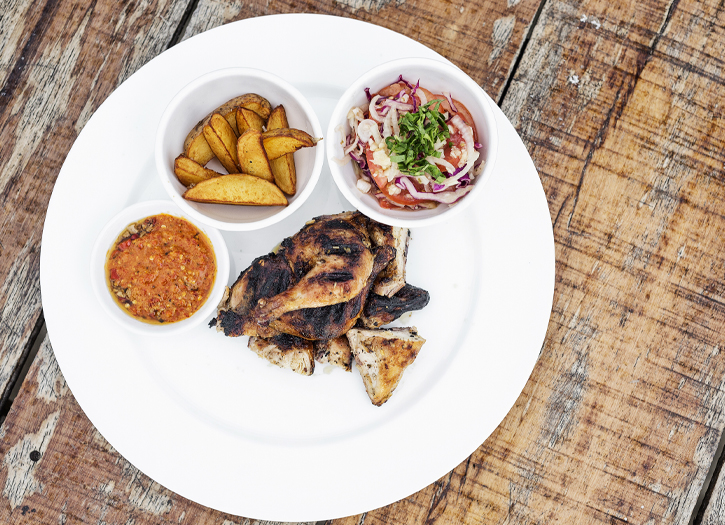Angolan cuisine has many dishes popular among nationals and foreigners.
One of the most popular being funge (which is made from the cassava or corn flour), mufete (having grilled fish, plantain, sweet potato, cassava, and gari). There is also calulu, moamba de galinha, moamba de ginguba, kissaca and so many more delicious dishes. Staple ingredients include beans and rice, pork and chicken, various sauces, and vegetables such as tomatoes, onions. Spices such as garlic are also frequently seen. Funge, a type of porridge made with cassava is a staple dish.
There are many influences from Portuguese cuisine like the use of olive oil. Piripiri is a local hot sauce. Funge (or funje, Portuguese pronunciation: [ˈfũʒɨ̥]) and pirão ([piˈɾɐ̃w]) are very common dishes, and in poorer households often consumed at every meal. The dish is often eaten with fish, pork, chicken, or beans. Funge de bombo ([dɨ ˈbõbu]), more common in northern Angola, is a paste or porridge of cassava (also called manioc or yuca), made from cassava flour. It is gelatinous in consistency and gray in color. Pirão, yellow in color and similar to polenta, is made from cornflour and is more common in the south.
Fuba ([fuˈba]) is the term for the flour that is used to make either funge and pirão, also used to make angu, the Brazilian polenta. Both foods are described as bland but filling and are often eaten with sauces and juices or with gindungo (see below), a spicy condiment. Muamba de galinha (or chicken moamba, [ˈmwɐ̃ba dɨ ɡɐˈɫĩɲɐ]) is chicken with palm paste, okra, garlic and palm oil hash or red palm oil sauce, often served with rice and funge. Both funge and moamba de galinha have been considered the national dish. A variant dish of moamba de galinha, muamba de ginguba, uses ginguba ([ʒĩˈɡubɐ], peanut sauce) instead of palm paste.
Other dishes common in Angolan cuisine include:
- Arroz(rice) dishes, including arroz da Ilha (rice with chicken or fish), arroz de garoupa da Ilha ([ɐˈʁoʑ dɨ ɡɐˈɾo(w)pɐ dɐ ˈiʎɐ], (rice with grouper), and arroz de marisco ([mɐˈɾiɕku], white rice with seafood, typically prawns, squid, white fish, or lobster).
- Cabidela([kɐbiˈðɛɫɐ]), a dish cooked in blood, served with rice and funge. Frequently chicken (galinha de cabidela, galinha à cabidela), served with vinegar, tomatoes, onion and garlic. It was also incorporated to Brazilian cuisine.
- Caldeirada de cabrito([kaɫde(j)ˈɾaðɐ dɨ kɐˈβɾitu]), goat meat stew served with rice, a traditional dish for Angolan independence day, November 11.
- Fish stews, including caldeirada de peixe([dɨ ˈpe(j)ʃɨ̥]), made with “whatever is available” and served with rice, and muzongue ([muˈzõɡɨ̥]), made from whole dried and fresh fish cooked with palm oil, sweet potato, onion, tomato, spinach, and spices, and served with rice, spinach, funje, and farofa; some Angolans believe that the stew is a hangover cure if eaten before the onset of the headache.
A number of beverages, alcoholic and non-alcoholic, are typical to Angola.Various homemade spirits are made, including capatica (made from bananas).







Add Comment
You must be logged in to post a comment.